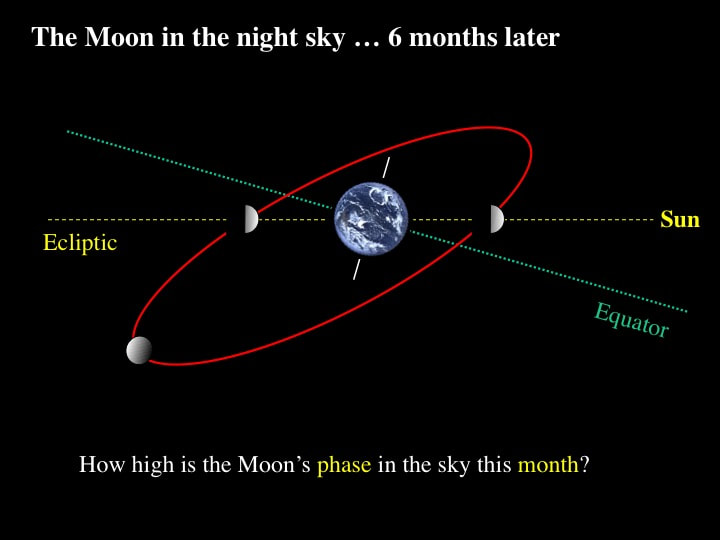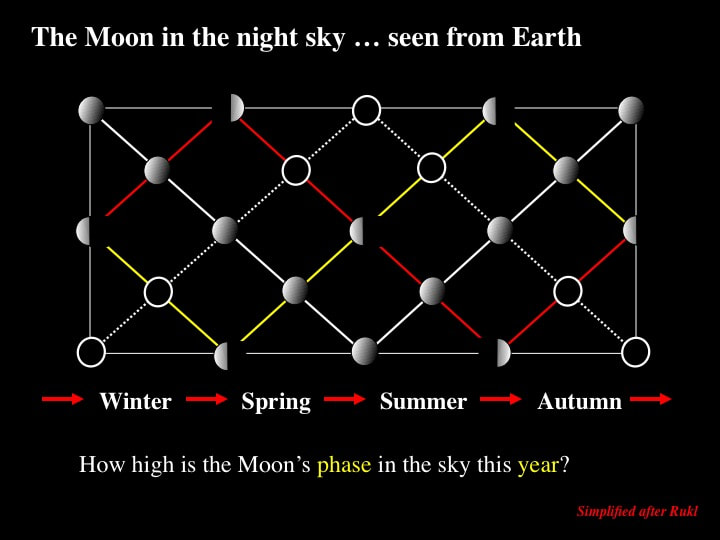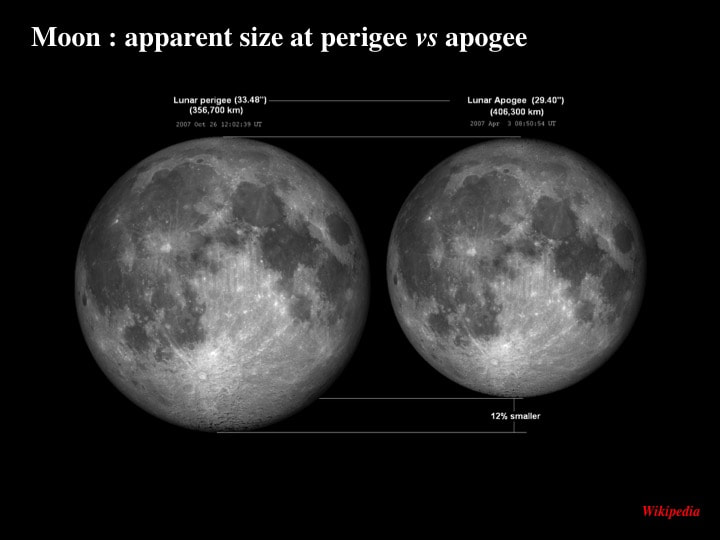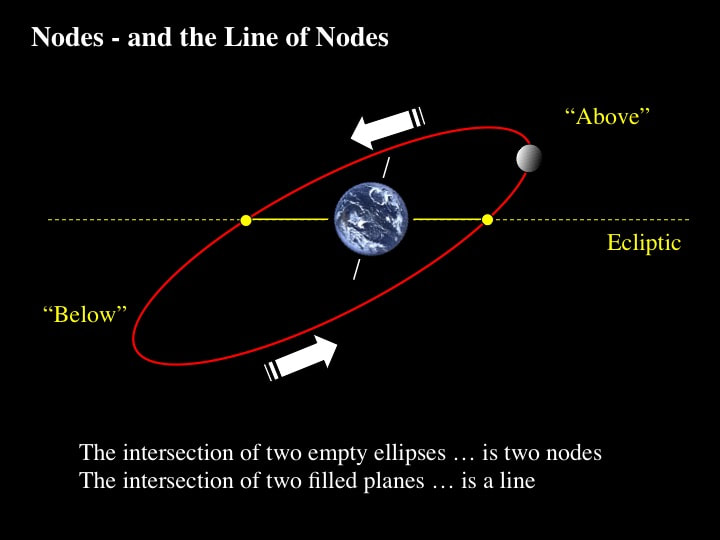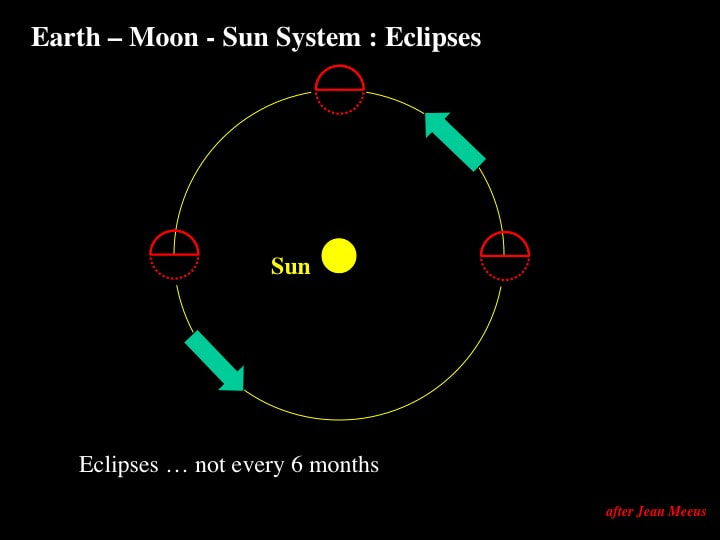|
Moon
|
As an amateur astronomer with a geological background, I enjoy observing the Moon through a telescope, especially from my light polluted urban backyard. However, the Moon isn't always where I expect it to be between all too rare observing opportunities. Sometimes it's way above my neighbours' roofs, while at other times it's so low in the sky that it's hidden by the neighbours' houses. I decided it was time to educate myself in the comings and goings of our nearest and most observable neighbour : the only celestial body whose geography - and geology - can be revealed by even a modest amateur telescope. This turned out to be a complicated story. So, in order to get the point across, I have opted here to tell the story step-wise, initially introducing concepts in an overly simplistic form, and subsequently layering on the complications that reflect the reality of orbital mechanics.
First, I have to point out a problem of scale. Here's the true size and scale of the Earth and Moon, and the distance separating them. If I used true scale in the following illustrations, you wouldn't be able to make out head or tail. Hence my graphics are truly Mickey Mouse sketches, but I think they get the message across.
So let's start with a very simple Earth-centric reference frame. The Earth spins on its axis like a child's spinning top, and thereby defines the equatorial plane.
Let's now add the Moon and its orbital plane, so that we are now looking at the Earth-Moon System. Remember that the Moon rotates on its own axis in the time it takes to orbit the Earth, so we always see the same face of the Moon. This is nothing special : most moons do the same thing, for reasons I won't get into here. However, for quite a different reason, the Earth-Moon System is quite remarkable. Of the large moons in the Solar System, only the Earth's Moon and Neptune's moon Triton do not orbit in the equatorial plane of their host planet. Although Saturn's Iapetus shows the same behaviour, and is larger than a small moon, it is not in the same size class as Earth's Moon or Triton. Even Uranus - with its axis of rotation almost lying within the ecliptic plane (that approximately contains the orbits of all the planets), and therefore with its equatorial plane nearly perpendicular to the ecliptic - is surrounded by moons that orbit the planet within the planet's equatorial plane. Triton is weird in any event because it orbits "backwards" around Neptune, which is why most astronomers assume that Triton was a wandering "rogue" body, captured by Neptune sometime in the early history of the Solar System. Which leaves our Moon - whose orbital plane sits at approximately 28° to the Earth's equatorial plane - unique in terms of its orbital behaviour, at least in its size class and in our Solar System.
If you now add the Solar System's ecliptic plane to the Earth-Moon System, we have yet a further complication. The Earth's spin axis is itself tilted at approximately 23 degrees to the ecliptic plane, which then means that the Moon - while orbiting close to the ecliptic - makes an angle of approximately 5 degrees with the plane in which the rest of the Solar System tends to orbit and rotate.
Here the orbital plane of the Moon is represented as a red ellipse, tilted with respect to our point of view and - to keep things simple - the Solar System's ecliptic and Earth's equatorial planes are represented as simple traces or lines. Depending on where the Moon is on its orbital Merry-Go-Round about the Earth, it will sometimes be above the ecliptic and/or the equatorial planes, and sometimes below. Because the Earth spins on its axis much faster than the Moon orbits around the Earth, this "height-in-the-sky" determination is not a function of the time of day - it's clearly a function of the time of the month.
If we now introduce the Sun into the picture, we can predict which phases of the Moon within a given month will ride high in the sky, and which will ride low. In this particular example - looking at the Earth-Moon system from space - the full Moon as seen from Earth's northern hemisphere will ride just above the equatorial plane, and therefore moderately high in the sky (just above my neighbours' rooftops) - while two weeks later, the new Moon will sit below the horizon. In between, the half illuminated Moon (as seen from Earth) is the phase that will ride the highest in the sky for northern astronomers, and I will easily see it from my backyard way above my neighbours' houses.
However, there's a further complication; the Earth orbits the Sun. Therefore, approximately 6 months later, when the Earth-Moon System is on the other side of the Sun, the height in the sky of the different phases of the Moon observed by northern astronomers is reversed.
The iconic Atlas of the Moon by Rukl contains a diagram that shows how the height in the sky of the different phases of the Moon varies throughout a given year as a function of the orbit of the Earth-Moon System around the Sun. I've tried to reproduce it here, but PowerPoint drawing tools are limiting. Hence the straight lines shown here should really be curves, but you'll get the point. Note how the New Moon (black) rides high in the summer and low in winter. The Full Moon (white) rides low in summer and high in the winter. You can trace the "height-in-the-sky" for the 1st and 3rd quarter Moons by following the red and yellow tracks, respectively
Now the complications start. Because the Moon's orbit is an ellipse - and not a circle - the separation of the Moon from the Earth varies over the course of a lunar cycle, between closest approach (perigee) and greatest separation (apogee).
This means that the apparent size of the Moon also varies - as you can see here : perigee vs apogee
So let's now add another variable to the Earth-Moon System; one that was first derived by Johannes Kepler in the early 17th century. Kepler determined that, when the Moon is close to perigee, its orbital speed is greater than when it's close to apogee.
This phenomenon lets you see around the corner and glimpse a small part the other side of the Moon. The constant spin or rotational speed of the Moon about its own axis - combined with a faster than average orbital speed when passing perigee - means that the Moon has orbited beyond 90 degrees in the time it takes to rotate 90 degrees. Hence we get to see a bit more of the Moon along its trailing edge. As the Moon slows its orbital speed swinging around apogee, the reverse occurs and we get to see around the leading edge of the Moon. Technically this phenomenon is known as the "Libration of Longitude", and you can find predictions of what it means for observing every month in the main astronomy magazines, or on the web.
So if we now put perigee, apogee, and libration together ... this is how the Moon would appear to you - speeded up - if you could stare at it without taking a break for a month! Note the changing apparent size, the "rocking" left and right, and the migrating terminator and shadow patterns. This is why one look at the Moon is never enough - it's forever changing its appearance
So if we now put perigee, apogee, and libration together ... this is how the Moon would appear to you - speeded up - if you could stare at it without taking a break for a month! Note the changing apparent size, the "rocking" left and right, and the migrating terminator and shadow patterns. This is why one look at the Moon is never enough - it's forever changing its appearance
Now that we've established the fundamental components of the Moon's orbital geometry, let's take a look at some of the consequences. Because the Moon's orbit is oblique by about 5 degrees to the ecliptic plane, it intersects the ecliptic at two points; technically referred to as "nodes". The line linking the two nodes is called the "line of nodes" ... and it lies in the ecliptic plane - by definition. This diagram tells us that, for most of the time in any given lunar orbital cycle, the Moon is either above or below the line of nodes. So the question is: what happens when the Moon coincides with the line of nodes? The answer is : it all depends on the Sun.
The Sun - by definition - lies in the ecliptic plane. According to this overly simplified diagram, when the Moon lies along the line of nodes, the Sun, Earth and Moon are in line - and lucky observers on Earth get to see an eclipse. Which kind of eclipse depends on the location of the Moon along the line of nodes. Here we see the Moon located at the node between the Earth and the Sun, which results in a Solar Eclipse as the Moon blocks the light of the Sun.
In contrast, when the Moon is located at the node on the far side of the Earth from the Sun, we get to see a lunar eclipse as the Moon enters the Earth's shadow. Now we have a major problem. These last two diagrams imply that we should see a total Solar Eclipse every month, followed by a total lunar eclipse two weeks later. Clearly, this is not what happens. In fact, eclipses were notoriously difficult to predict for most pre-scientific societies, as some astrologers found at the cost of their lives ! If we want to understand the role of the Moon in eclipses, we need to introduce two more complications to the story so far.
Here's the first. So far we've talked about the long axis of the elliptical orbit of the Moon as though it was fixed in orientation with respect to the stars; well, it's not ! It rotates - in the same direction as the Moon orbits the Earth, and the Earth spins on its axis and orbits the Sun. In other words, in the same direction that most planets and moons orbit and rotate in our Solar System. This rotation of the long axis of the lunar orbital plane takes about 9 years to complete.
Here's the second complication. The line of nodes also rotates within the ecliptic plane, over a period of nearly 19 years - about twice as long as the rotation of the long axis of the lunar orbital plane - but it rotates in the opposite (retrograde) sense. Why is this important ? It's important because the rotation of the line of nodes within the ecliptic plane really makes a mess of predicting when the line of nodes will point toward the Sun, and therefore when eclipses can occur. All of which means that predicting when eclipses (lunar or solar) will occur depends on knowing when the Moon is located at one node or the other - and - when the line of nodes is aligned with the Sun. This is not an easy problem to understand, but I'll try to walk you through it as simply as I can.
First we need to address the question : how do things rotate both forwards and backwards at the same time ? If we look at a simple orbital ellipse (red dotted) and its intersection with the ecliptic (yellow solid) we can define the line of nodes (yellow dotted). If the orbital ellipse now rotates (red solid), the line of nodes (yellow solid) must rotate in the same sense.
Something’s wrong ! What are we missing here ? "Precession" : essentially the same wobble you see in a child's spinning top, just before it falls over. Here's a simple representation of a spinning disk (red) and its spin axis (white) : think of it as a spinning top that wobbles. If we represent three different positions of the wobbling spinning top and introduce an ecliptic plane (yellow), we see that the line of nodes has not moved. This is because I cannot draw – and have only represented a 2D back-and-forth rocking of the top.
In true precession of the top (which I still can’t draw !), the line of nodes would rotate in 3D, either prograde or retrograde, depending on the sense of the wobble. Now forget the child's "top". Imagine the elliptical orbital plane of the Moon with a stake through it at 90° (what's called a "normal"). The orbital plane slowly precesses such that its normal wobbles clockwise, resulting in a retrograde (clockwise) rotation of the line of nodes, while the long axis of the orbital plane itself rotates anticlockwise (prograde), at a faster speed.
Why does the Moon’s orbital plane precess? Frankly, I’m not a physicist, so I can’t tell you. However, I think it is likely a consequence of the fact that the orbital plane lies between two theoretically stable orbital planes : the Earth’s equatorial plane at the local scale and the Ecliptic plane of the Solar System as a whole. My educated guess would be that it is trying to “oscillate” between these two stable planes. I’m sure that someone more expert than me could elaborate on this ... possibly in terms of gravitational interactions within a multi-body system.
In true precession of the top (which I still can’t draw !), the line of nodes would rotate in 3D, either prograde or retrograde, depending on the sense of the wobble. Now forget the child's "top". Imagine the elliptical orbital plane of the Moon with a stake through it at 90° (what's called a "normal"). The orbital plane slowly precesses such that its normal wobbles clockwise, resulting in a retrograde (clockwise) rotation of the line of nodes, while the long axis of the orbital plane itself rotates anticlockwise (prograde), at a faster speed.
Why does the Moon’s orbital plane precess? Frankly, I’m not a physicist, so I can’t tell you. However, I think it is likely a consequence of the fact that the orbital plane lies between two theoretically stable orbital planes : the Earth’s equatorial plane at the local scale and the Ecliptic plane of the Solar System as a whole. My educated guess would be that it is trying to “oscillate” between these two stable planes. I’m sure that someone more expert than me could elaborate on this ... possibly in terms of gravitational interactions within a multi-body system.
So much for theoretical explanations; what does this really mean for eclipses? Here's what the Earth-Moon System would look like without rotation or precession of the lunar orbit. The yellow circle approximates the ecliptic, and the red circle approximates the orbit of the Moon around the Earth. The solid part of the red circle is the lunar orbit above the ecliptic, and the dashed part is the orbit below the ecliptic. At right, the solid diameter of the circle is the line of nodes pointing at the Sun, so an eclipse could occur here - depending on where the Moon is on its orbital path. At top we see the Earth-Moon System 3 months later. The line of nodes does not point at the Sun, so clearly no eclipses can occur here - wherever the Moon is ! Finally, at left, six months later it's potentially eclipse time again because the line of nodes is pointing at the Sun, depending on where the Moon is on its orbital track.
But this is too simple and will lead to wrong predictions, so let's introduce retrograde (clockwise) precession of the lunar orbit. At Time = T1, we are set up for a potential eclipse because the line of nodes is aligned with the Sun, depending on where the Moon is. Remember, the line of nodes will rotate clockwise (retrograde). At Time = T2, the alignment of the line of nodes with the Sun gives us another potential eclipse opportunity, again depending on where the Moon is. However, because of the retrograde (clockwise) rotation of the line of nodes, it took less than 6 months for this alignment to re-occur.
Let's re-enforce this point by observing that the next return of the alignment of the line of nodes with the Sun at Time = T3 is clearly not coincident with the position of the Earth at Time = T1 . In other words this is not an annual cycle and, of course, we need to know where the Moon is as well - in order to predict eclipses.
But this is too simple and will lead to wrong predictions, so let's introduce retrograde (clockwise) precession of the lunar orbit. At Time = T1, we are set up for a potential eclipse because the line of nodes is aligned with the Sun, depending on where the Moon is. Remember, the line of nodes will rotate clockwise (retrograde). At Time = T2, the alignment of the line of nodes with the Sun gives us another potential eclipse opportunity, again depending on where the Moon is. However, because of the retrograde (clockwise) rotation of the line of nodes, it took less than 6 months for this alignment to re-occur.
Let's re-enforce this point by observing that the next return of the alignment of the line of nodes with the Sun at Time = T3 is clearly not coincident with the position of the Earth at Time = T1 . In other words this is not an annual cycle and, of course, we need to know where the Moon is as well - in order to predict eclipses.
OK: so you thought that the simplest possible astronomical observation was to look up in the sky - night or day - and spot the Moon. Now you know better ! Try as I may to make this stuff simple, it's inherently complicated because we're talking about "wheels" within "wheels", the "wheels" aren't circular, their shapes change orientation, and they wobble - and this is just the orbital paths, not the objects doing the actual orbiting!
This is not easy to assimilate, and some of you may go looking for things to read to get a better handle on all this. If you do, you're going to come across some unavoidable vocabulary. For example, what's the definition of a lunar month? The answer? : that depends on your reference frame.
This is not easy to assimilate, and some of you may go looking for things to read to get a better handle on all this. If you do, you're going to come across some unavoidable vocabulary. For example, what's the definition of a lunar month? The answer? : that depends on your reference frame.
Let's start with Luna (the Moon) at L1; this is the New Moon with the Moon interposed between the Earth and the Sun. Seen from above the ecliptic (yellow), the Moon orbits (red) the Earth (green) in an anticlockwise direction in the same sense as the Earth orbits the Sun. A "month" later, at L2, the Moon returns to the same position with respect to the stars, but - because the Earth has moved with respect to the Sun - we on Earth have to wait for the Moon to keep orbiting the Earth a little longer before we see the next New Moon. To summarise: the time required for the Moon to return to the same position with respect to the stars is called a Sidereal Month (from the Latin for star), and it takes ~27.3 days to complete. The time between two New Moons, as seen from Earth, is called the Synodic Month (from the Greek for meeting - or the convergence of paths), and it takes ~29.6 days, ~2.3 days longer than the Sidereal month, in order to compensate for the orbit of the Earth about the Sun. Think of it this way; the Sidereal Month is a month of absolute rotational positions, while the Synodic Month is a month of lunar phases relative to us on Earth.
Sidereal and Synodic months are commonly used terms when talking about the Moon, but even the RASC Observer's Handbook refers cryptically to two other lunar cycles: Anomalistic and Draconic, with little or no explanation. If you've stuck with me this far, these monthly cycles are now easy to explain. The Anomalistic month is simply the Sidereal month plus a small correction of 0.2 days to allow for the prograde rotation of the long axis of the elliptic orbit of the Moon. The Draconic Month is the Sidereal month minus an even smaller correction of 0.1 days to allow for the retrograde rotation of the line of nodes, due to the wobble of the lunar orbit.
Proudly powered by Weebly







